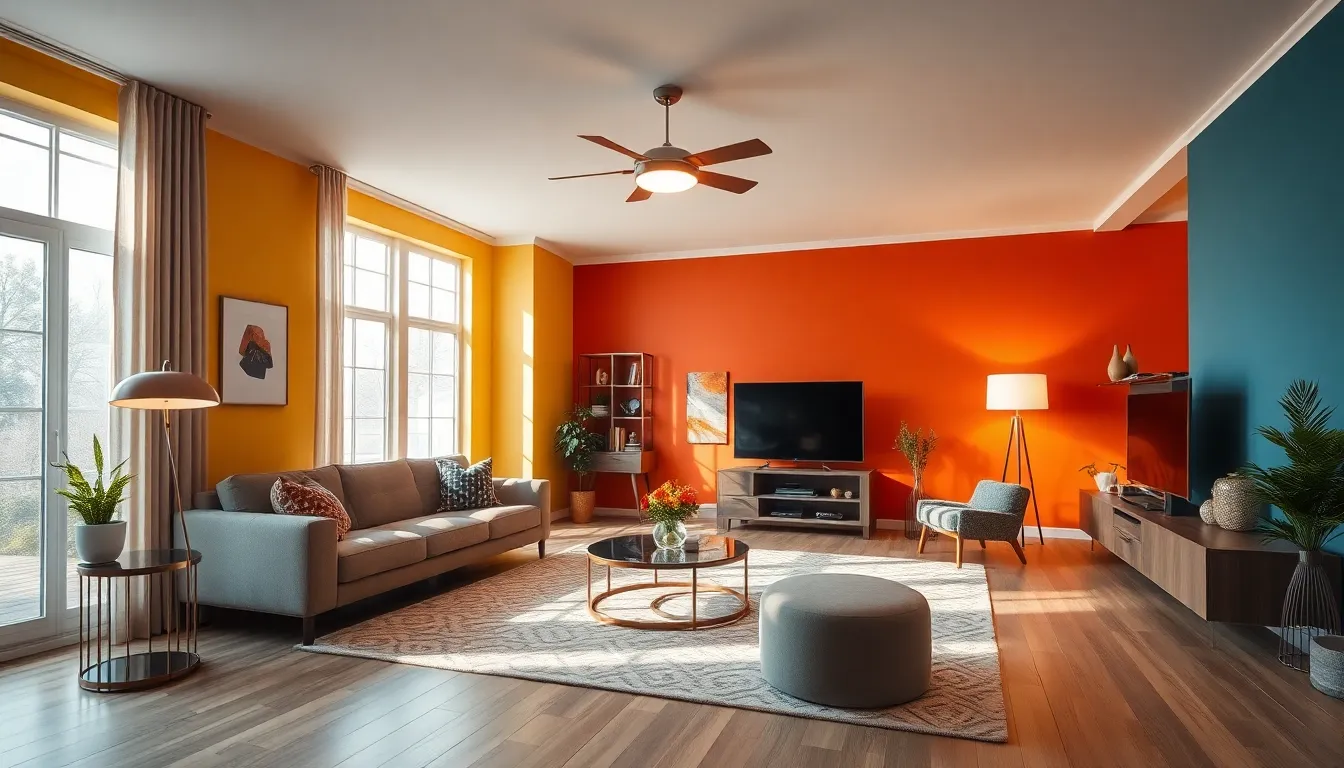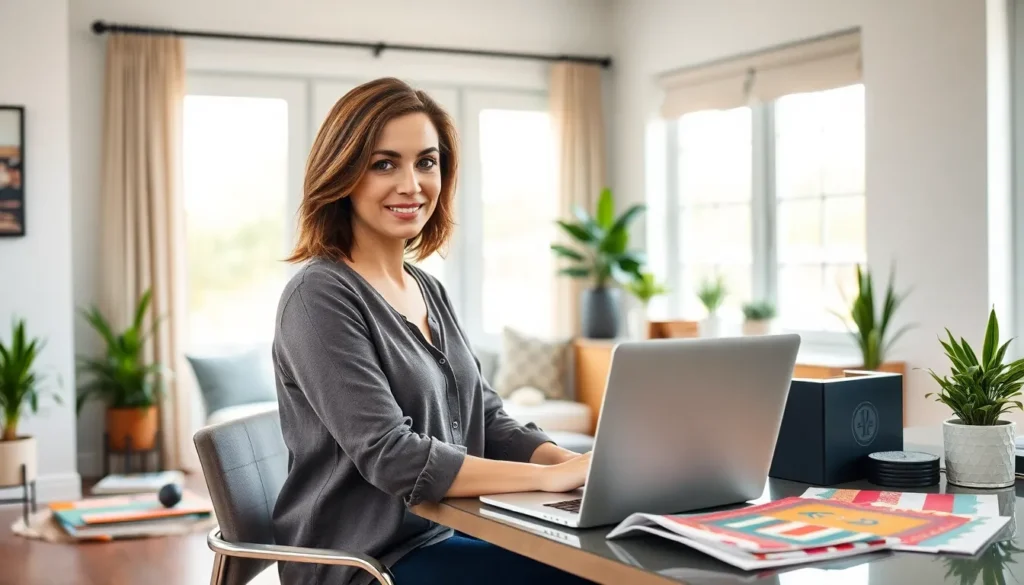Transforming a house into a home is like dressing up for a big night out—it’s all about making a statement. Whether it’s a cozy nook for reading or a vibrant space for entertaining, interior design plays a crucial role in how one experiences their living environment. Imagine stepping into a room that reflects personality and style, where every corner whispers, “Welcome home!”
But let’s face it, not everyone has an eye for design. If choosing between a chic sofa and a questionable floral pattern feels like selecting a life partner, you’re not alone. Fear not! With a sprinkle of creativity and a dash of inspiration, anyone can master the art of interior design. Dive in, and discover how to turn those four walls into a canvas that showcases your unique flair while keeping it functional and fabulous.
Table of Contents
ToggleOverview of House Interior Design
House interior design encompasses the art and science of enhancing a home’s interior. It combines aesthetics with functionality to create spaces that serve specific purposes. Styles vary widely, from modern and minimalist to traditional and eclectic. Each style reflects personal taste and influences how occupants experience their environment.
Color selection plays a crucial role in interior design. Colors can evoke emotions and influence mood. For example, soft blues and greens promote tranquility, while vibrant reds and oranges stimulate energy. Incorporating a harmonious color palette fosters a cohesive look throughout the space.
Furniture selection also significantly impacts overall design. It should balance comfort and style, ensuring that pieces complement each other while fulfilling practical needs. Proper arrangement enhances flow and usability, making it easy to navigate and enjoy each space.
Lighting is essential in setting the atmosphere. Various options include ambient, task, and accent lighting. Each type serves a unique purpose, from illuminating work areas to highlighting artwork. Using layered lighting adds depth and dimension to any room.
Textures and materials contribute to the visual appeal and tactile experience. Combining different textures, such as fabrics, wood, and metals, adds interest and depth. Thoughtfully chosen materials can enhance a space’s character and evoke warmth or sophistication.
Incorporating personal touches personalizes a home’s interior. Family photos, artwork, and heirlooms create a unique narrative, reflecting the owners’ journey. Elements like plants and decorative accents bring life and vibrancy while improving air quality.
Ultimately, successful interior design balances aesthetics and functionality. It ensures every element works cohesively to enhance the living experience. Engaging with various resources, such as magazines and online platforms, inspires creativity in transforming a house into a home.
Key Elements of House Interior Design

House interior design incorporates various components that collectively enhance the overall ambiance of a space. Each element contributes to crafting a functional and aesthetically pleasing environment.
Color Schemes
Color schemes play a vital role in setting the tone of interior spaces. Warm colors, such as reds and yellows, evoke energy and vibrancy, while cool colors like blues and greens promote calmness and tranquility. Neutral colors provide a versatile backdrop, allowing other design elements to stand out. Designers often suggest using a base color paired with two complementary shades for harmony. They recommend considering natural light when selecting colors, as it significantly affects how hues appear throughout the day.
Furniture Selection
Furniture selection impacts both comfort and design. Prioritizing functionality ensures that each piece serves a purpose while enhancing the overall aesthetic. Sofas, chairs, and tables should match the selected design style, whether it’s modern minimalist or classic traditional. Durability remains essential; choosing materials that withstand daily use ensures longevity. Arranging furniture to facilitate movement fosters an inviting atmosphere. Moreover, incorporating statement pieces adds personality, creating focal points within the design.
Lighting Techniques
Lighting techniques establish mood and functionality in interiors. A combination of ambient, task, and accent lighting creates depth and interest. Ceiling fixtures provide general illumination, while table lamps and wall sconces offer targeted light for various activities. Utilizing dimmers allows for brightness adjustment, catering to different needs throughout the day. Natural light sources, like windows and skylights, enhance a room’s appeal and energy efficiency. Selecting light fixtures that complement the overall design style enhances the visual coherence of the space.
Popular Styles in House Interior Design
Various styles in house interior design cater to diverse tastes and preferences, offering unique aesthetics and functionalities. Understanding these styles helps homeowners create spaces that resonate with their personal identity.
Modern Design
This style showcases clean lines and open spaces. It emphasizes simplicity while incorporating sleek, contemporary furniture. Neutral colors, alongside bold accents, play a significant role in modern interiors. With large windows often integrated, natural light floods the spaces, enhancing the overall ambiance. Minimalistic décor focuses on fewer items that maintain an elegant yet functional feel. Accessories include geometric shapes and modern art, making each room striking without overwhelming it.
Traditional Design
Traditional design evokes warmth and comfort, reminiscent of classic styles. Rich wood furniture and intricate detailing characterize this aesthetic, creating a sophisticated atmosphere. Warm color palettes, featuring deep reds and golds, contribute to a cozy environment. Textiles like plush fabrics and patterned wallpaper enhance visual interest while maintaining an air of elegance. Personal items, such as heirlooms and antiques, typically adorn spaces, making them feel inviting and lived-in.
Minimalist Design
This style emphasizes the principle of “less is more.” It focuses on functionality while eliminating excess clutter. Neutral tones dominate minimalist interiors, creating a calming effect. Furniture often features simple shapes and is chosen for utility rather than ornamentation. Open floor plans further promote a sense of space, making each area feel airy and unobstructed. A few carefully chosen accessories add personality without overwhelming simplicity.
Tips for Effective House Interior Design
Effective house interior design requires careful consideration and planning. Thoughtful space planning leads to a functional layout that maximizes both comfort and usability.
Space Planning
Space planning defines how furniture and elements flow within a room. Identify the purpose of each area to optimize layout. Consider movement patterns when arranging furniture; pathways should remain clear. Prioritize focal points, such as a fireplace or artwork, to draw attention. Use an appropriate scale when selecting furnishings, ensuring pieces complement each other. Create conversation areas with seating arrangements to enhance social interaction. Lastly, incorporate storage solutions to maintain organization and reduce clutter.
Personalization
Personalization expresses individual style within the home. Begin by selecting a color palette that resonates with personal tastes, choosing shades that evoke desired emotions. Incorporate meaningful artwork or family photographs to add character and warmth. Custom touches, such as handmade accessories or heirlooms, create a distinctive ambiance. Reflect hobbies or interests through decor and furnishings, unveiling the owner’s personality in each space. Layer textures and materials to enhance visual interest. Lastly, rotate seasonal decor to refresh interiors while showcasing variety.
Transforming a house into a home through thoughtful interior design is a rewarding journey. By understanding the balance between aesthetics and functionality, anyone can create a space that truly reflects their personality. Embracing different design styles allows for endless possibilities, ensuring each room tells its own story.
Incorporating personal touches enhances the overall atmosphere, making it inviting and warm. With careful planning and a keen eye for detail, homeowners can harmonize elements like color, furniture, and lighting to elevate their living experience. The right design choices not only beautify a space but also foster comfort and connection.





